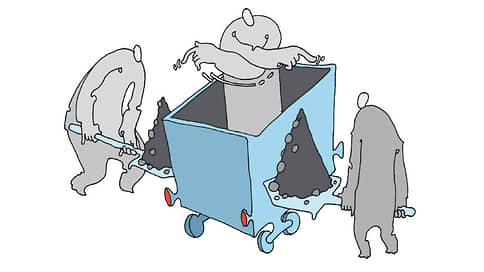Coal is planted from the first class
[ad_1]

The head of OJSC Russian Railways, Oleg Belozerov, again proposed radically changing the principles of tariffing for coal transportation in order to remove the burden of subsidizing the coal industry from the railways and shift it to the regions. We are talking about changing the tariff class of coal from the first – the cheapest – to the standard second. According to expert calculations, on average, transportation of goods of the second tariff class is 2.3 times more profitable for Russian Railways, although depending on the specific coefficient, the figure may be higher. For example, the coefficient that was planned to be assigned to coal in 2022 would have brought Russian Railways more than 300 billion rubles. in year. Coal industry experts consider the measure unjustified and expect that in this case, the marginality of coal companies’ business will be reduced by 20–30%, and some export routes will be closed.
On November 25, the head of Russian Railways Oleg Belozerov sent a letter (available to Kommersant) to First Deputy Prime Minister Andrei Belousov with a proposal to sharply increase tariffs for coal transportation. Russian Railways did not comment, and Mr. Belousov’s secretariat did not respond to Kommersant’s request.
“It is necessary to note,” writes Oleg Belozerov, “that currently support for the coal industry is carried out on a systematic basis through the price list No. 10-01 (the main tariff document of JSC Russian Railways.— “Kommersant”) cross-subsidization mechanism, that is, by lowering tariffs for the transportation of coal by rail.” He notes that coal belongs to the first tariff class. Now there are three tariff classes on the railway: the standard second, the first, where prices are calculated with a discount to the second (a coefficient of 0.55–0.75), and the third, the most expensive, with a premium (1.54–1.74). Coal transportation, in addition to first-class tariffs, had a number of special benefits until mid-2022 – in particular, reduction factors of 0.4 for transportation over a distance of over 3.3–3.5 thousand km, and 0.895 for transportation of thermal coal for export. They were canceled on June 1, 2022, since then the cancellation has been periodically extended and is still in effect (see “Kommersant” dated May 29, 2022).
Mr. Belozerov proposes to classify coal as cargo of the second tariff class, “and the authority to determine the need to provide state support to enterprises in the coal industry, taking into account the full structure of costs for the extraction and transportation of coal, as well as market conditions, should be transferred to the state authorities of the constituent entities of the Russian Federation, as well as the right to make appropriate decisions.” In his opinion, this will allow “to get away from implicit subsidies of the coal industry” and will enable regions to “independently assess the feasibility of providing such support, taking into account the balance of development of various sectors of the economy on their territory.”
Farid Khusainov, an expert at the Institute of Economics and Regulation of Infrastructure Industries at the Higher School of Economics, notes that coal has been in the first tariff class since 1995, when the division into three tariff classes appeared, and was placed there among other goods for which the transport component of the price is the highest. As world coal prices periodically increased significantly, the idea arose that while coal for domestic Russian consumption might not withstand higher tariffs, those intended for the world market would. However, according to Mr. Khusainov, for such an option to have the right to exist, all the grounds for changing tariffs must be clearly formulated. In general, he believes, the economics of coal transportation will change significantly when the class changes. He notes that in 2022, the average income rate for first-class cargo was 342.9 kopecks per ten ton-kilometers, for the second – 789.3 kopecks, that is, 2.3 times more.
However, he notes, all classes have lower and upper limits, so the price difference will be clear when a more specific proposal from Russian Railways appears: for example, transportation of coal is 3.3 times cheaper than transportation of the “oil and petroleum products” group (second class).
In 2022, Russian Railways already proposed to transfer coal to the second tariff class, and not at the lowest limit – changing the coefficient for cargo class from April 1 from 0.55–0.75 to 1.346 (see Kommersant of March 18, 2022 ). This measure, without taking into account the abolition of preferential coefficients, would have brought the monopoly 231.3 billion rubles. additional income until the end of 2022. According to AC FEC estimates, in this case, supplies of thermal coal from Kuzbass in the eastern and western directions would become unprofitable, and the shortfall in exports to the coal regions would amount to 131.2 million tons.
The transfer of coal to the second tariff class is a very strange idea against the backdrop of the constant increase in tariffs of Russian Railways, including for the development of the Eastern polygon, believes independent industrial expert Maxim Shaposhnikov. “Subsidizing the coal industry at the expense of regions that are already subsidized and dependent on taxes paid by coal miners is a so-so idea, since profits from the operation of enterprises are mainly consolidated on trading structures registered outside the mining regions,” he believes. For the coal industry, according to his calculations, this will mean a drop in margins by 20–30% and the closure of some export routes.
A source in the operator industry believes that if such a reform is carried out, it will be carried out entirely, and not for individual cargoes. Thus, he talks about the need to increase tariffs for the transportation of containers, which are noticeably underestimated, and to reduce prices for the main donors – transportation of oil and metals.
[ad_2]
Source link





